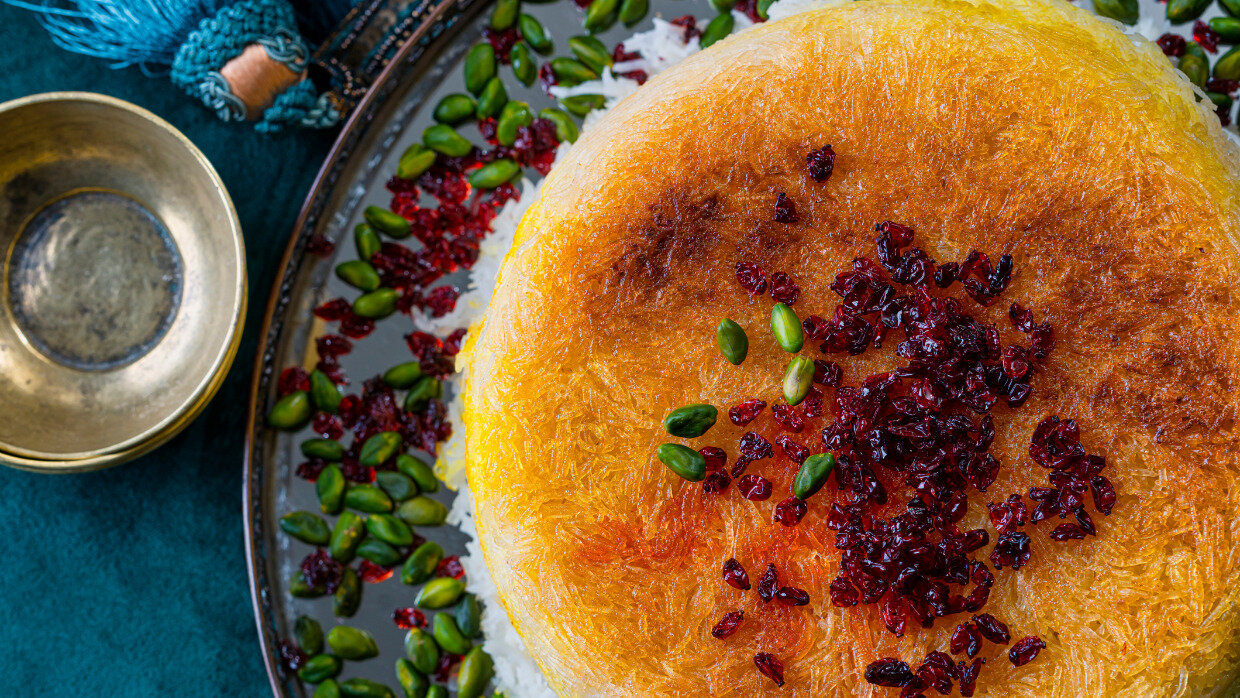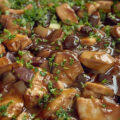Tahdig, the crispy, golden crust of rice that forms at the bottom of the pot when cooking Persian rice, holds a special place in the hearts and on the tables of Persian Jews worldwide. This simple yet deliciously complex dish connects Persian Jews to their cultural roots and the land their ancestors came from centuries ago.
Referred to by some as the holy grail of Persian cooking, Tahdig has become an Iranian specialty. It’s called Tahdig because “tah” translates to “bottom,” and “dig” means “pot” in Farsi.
As a child, my mother was very into cooking Persian food for us despite being an Ashkenazi Jew from Canada. But when it came to that crunchy bottom of the pot my siblings and I would fight over who got the golden brown crust until all that was left were potatoes, tagine, and a floor covered in rice.
But little did I know the time and dedication that went into making that Tahdig so freaking delicious. As with all great Jewish foods, tahdig is a labor of love. To get that iconic golden color to the crust, cooks use saffron, which is frequently cited as one of the most costly spices in the world but gives an incredible flavor to the otherwise plain rice dish. Many Persian Jews have fond memories of their mothers and grandmothers expertly flipping over pots to reveal the tahdig. But I’m sure many Grandmothers have less-than-fond memories of the number of tries it took to get there. Getting the rice to become golden without burning is a feat that utilizes the Maillard reaction, a phenomenon that occurs in baguettes and french fries and is what makes all those dishes caramelize.
Persian rice dishes are often served along with one of the numerous types of exquisite slow-cooked braises called “khoresh” (خورش). Popular khoreshes include yellow split pea khoresh and green herb khoresh that gets poured over the crunchy rice.
Burnt rice is not unique to Persian cuisine however, scorched rice dishes can be found all throughout the world. One example is Okoge, a blackened rice native to Japan that is usually eaten with vegetables. Latin America’s version of the dish goes by Cucayo. So what is it that makes Tahdig so special?
The origins of tahdig date back to rice cultivation in the northern regions of Iran. Rice has been grown in the Caspian Sea littoral for thousands of years, and Persians became masters at cooking the slender, aromatic grains. Tahdig likely emerged as a way to make the most of the crispy remnants of rice left in the pot after cooking. Over time, it evolved into an art form, and regional variations developed based on pot style and heat source.
A fascinating urban legend about Tahdig begins in the 1800s with the Iranian Qajar Dynasty who ruled the Persian Empire in the 1800s. According to the tale, the King's servants would enjoy the King's Leftovers as their meal the day after. Until one day, the servants started arguing at full volume over who gets the last bit of crunchy rice at the bottom of the pot.
The crispy rice commotion eventually became so loud and he asked to understand what the ruckus was about. After learning of Tahdig, he asked for it to be brought to him, and from then on, the crunchy rice at the bottom became a nightly tradition for him. Though maybe the servants weren't as excited with their leftovers after that.
 Carrot and Rice Pilaf with Tahdig
Carrot and Rice Pilaf with Tahdig
Whatever the truth of the tale, by the end of the nineteenth century, tahdig had gone big time. With everyone who's anyone trying their hand at the Persian delight, Tahdig even made its way to Israel.
While Jews have been living in Persia since around 727 BCE after being captured by the Assyrian and Babylonian kings it wasn’t until the wave of immigration from Iran to Israel in the 20th century that brought the dish to the forefront of Israeli cuisine.
For Persian Jews, tahdig is more than just a recipe—it represents the connection to the homes their families left behind in Iran. After many Persian Jews fled rising persecution in Iran following the establishment of Israel in 1948, tahdig became a poignant reminder of their roots. Cooking tahdig connected Persian Jewish immigrants across the diaspora to their shared culture and history.
 Stuck Pot Rice with Lentils and Yogurt
Stuck Pot Rice with Lentils and Yogurt
Today, tahdig remains a centerpiece at most Persian Jewish holidays and Shabbat meals. The dish has traveled with Persian Jewish communities from Iran to Israel to North America and beyond. For young Persian Jews born outside of Iran, tahdig offers a tangible connection to the lives their parents and grandparents knew. Each crispy bite transports them back to the aromas of an Iranian kitchen filled with simmering rice, saffron, and love.
Though simple on the surface, tahdig encapsulates the complex history of displacement, diaspora, and lasting cultural pride. More than just a crust, it represents the strength of Persian Jewish identity across borders and generations. The golden key to unlocking this history lies in sizzling rice at the bottom of the pot. By eating tahdig, we are invited to dig further into Persian Jewry’s fascinating history.



















Yes want the recipe please
Want recipes
So where are the recipes?